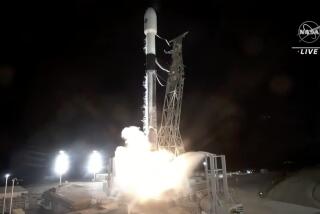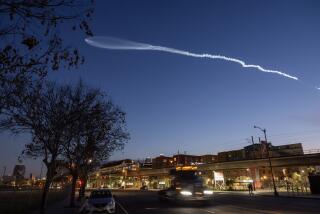Rocket Fuel Transportation Study Favors Trucks Over Trains, Barges
WASHINGTON — The Air Force has concluded that transporting dangerous rocket fuel to Vandenberg Air Force Base by rail through the San Fernando Valley and Ventura County deserves further study after an 18-month review of other means of transportation.
Foremost, however, the study found that the Air Force practice now of trucking the fuel through Southern California is preferable to shipping it by barge through the Panama Canal or transporting it by rail.
Pentagon officials said Tuesday that the study found that transporting the volatile chemicals--which are both poisonous and explosive--by barge is not feasible.
While officials decided that moving the fuel by rail through the San Fernando Valley merits further review, they found that trucking it through the Mojave Desert north of Los Angeles remains the best option, Capt. Sigmund Adams said.
The study was requested by Rep. Robert J. Lagomarsino (R-Ojai) in 1987 in response to reports that fuel components used to launch military rockets were being shipped by truck on the Ventura Freeway through the densely populated San Fernando Valley and northward through Ventura County.
The Air Force redirected the shipments after elected officials from the San Gabriel Valley, the San Fernando Valley and Ventura County protested.
A northern highway route through less-populated Barstow, Mojave, Gorman, Mariposa and Santa Maria was selected.
“These propellants have been shipped via tank trailer over the nation’s highways for more than 25 years without a single recordable accident or incident resulting in a spill or major loss of product while in transit,” said officials at the San Antonio Air Logistics Center at Kelly Air Force Base in San Antonio. The center conducted the study for the Air Force.
The report cited regulations prohibiting bulk shipments of rocket fuels by barge. It said that in an accident, either alternative method could jeopardize more people than trucking because barges and rail cars would carry larger shipments than trucks.
Lagomarsino has asked the House Merchant Marine Committee and Fisheries and Government Operations Committee to review the nearly 200-page study, which was released Tuesday.
Meantime, Lagomarsino expressed disappointment that the Air Force did not fully assess the prospect that shipping the rocket fuel by barge could enhance safety. He also dismissed consideration of the rail option.
“It would appear on the face of it the rail shipment would expose many more people to risk than the current truck routing,” said John Doherty, a senior aide to Lagomarsino.
Rail shipments would be carried on the Southern Pacific Railroad coastal route, which parallels the Ventura Freeway though the San Fernando Valley, eastern Ventura County and Santa Barbara.
Nitrogen tetroxide is transported across seven states from Vicksburg, Miss., where it is manufactured in 3,057-gallon tank trucks under contract to the Air Force. As many as two rocket fuel shipments are made each month, depending on Vandenberg’s launch schedule, although there have been none so far this year, said Phoebe Brown, a San Antonio Air Logistics Center spokeswoman.
The ocean transport proposal would have shipped the fuel by barge from Vicksburg down the Mississippi River to the Gulf of Mexico, through the Panama Canal and past Mexico to the California coast.
More to Read
Sign up for Essential California
The most important California stories and recommendations in your inbox every morning.
You may occasionally receive promotional content from the Los Angeles Times.










